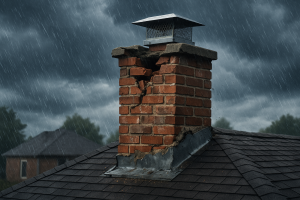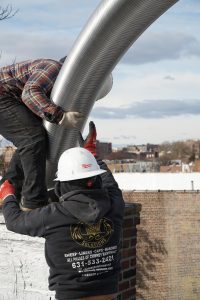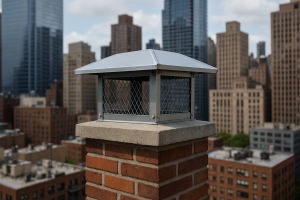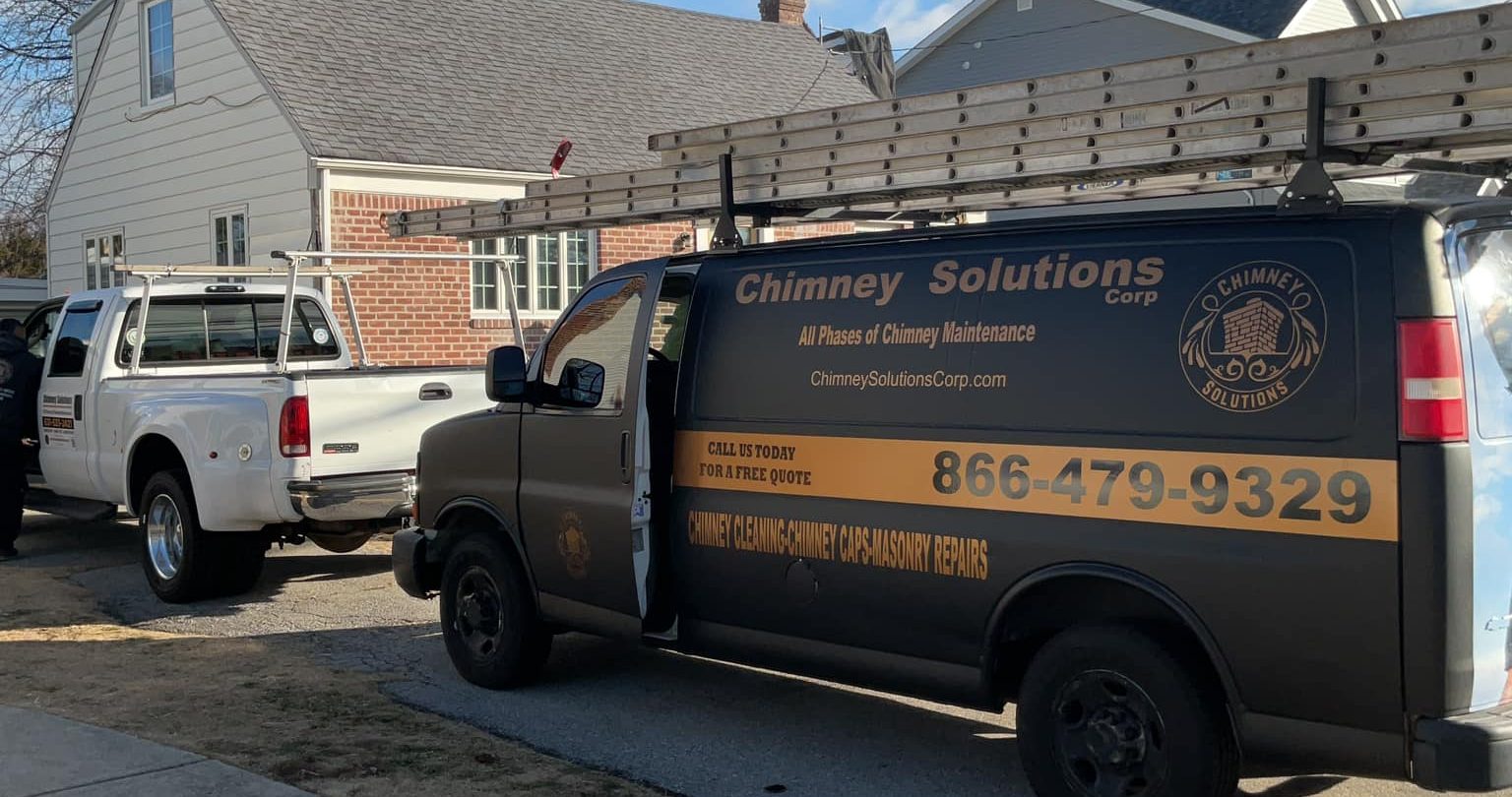A crackling fire on a chilly night offers warmth, comfort, and ambiance—but if you’re not paying attention to creosote buildup, that cozy moment can quickly turn into a serious safety hazard. This black, tar-like substance is a byproduct of the combustion of wood, and while it may seem harmless at first, creosote is highly flammable, toxic, and capable of causing chimney fires, carbon monoxide poisoning, and even permanent structural damage to your chimney.
At Chimney Solutions, our mission is to help you maintain a safe and efficient chimney system through regular chimney inspections, routine chimney cleanings, and education on key factors that influence fireplace performance. In this guide, we break down exactly why you should never ignore creosote buildup, how it forms, the risks involved, and what to do about it.
What Is Chimney Creosote?
Creosote is a sticky, dark residue that forms inside your chimney flue when wood burns, particularly under less-than-ideal conditions. It is composed of organic compounds, carbon particles, and byproducts of combustion like gases and moisture.
There are three stages of creosote:
- Stage 1: Flaky soot that’s easily brushed away.
- Stage 2: Tar-like substance that begins sticking to chimney walls.
- Stage 3: Glazed creosote – a hard, shiny, dangerous substance that’s extremely difficult to remove and requires specialized tools or chemical treatments.
How Does Creosote Form?
Creosote buildup happens when:
- Unseasoned or wet wood (like green wood or damp wood) is burned.
- The chimney temperature is too low for complete combustion.
- Poor airflow or inadequate ventilation prevents proper draft.
- Slow-burning fires are used for prolonged periods.
These conditions lead to incomplete combustion, which results in more creosote forming inside the chimney system.
The Hidden Dangers of Creosote Buildup
Ignoring creosote can lead to devastating consequences. Here’s what’s at stake:
Chimney Fires
Creosote is highly flammable, and its ignition is a leading cause of chimney fires in the U.S. According to the NFPA, these fires can cause millions in damage annually and are often entirely preventable.
Carbon Monoxide Poisoning
Creosote deposits can block the chimney flue, causing dangerous combustion gases—like carbon monoxide—to seep back into your home. Long-term exposure can result in shortness of breath, permanent brain damage, or even death.
Respiratory Issues
Creosote emits toxic fumes that can irritate your lungs, skin, and eyes. Long-term contact or exposure to creosote can lead to respiratory issues and skin conditions.
Structural Damage
The acidic nature of creosote can corrode chimney liners, crack chimney crowns, and damage brick surfaces, leading to costly repairs and compromised chimney performance.
Signs of Creosote Buildup
Identifying the obvious warning signs of creosote buildup early is a critical factor in protecting your home, health, and chimney system. Whether you rely on a wood stove, solid fuel appliances, or a traditional fireplace, failing to recognize these signals can lead to heating fires, toxic gas exposure, and even devastating damage to your home.
Be alert to the following symptoms of a dirty chimney or dangerous chimney conditions:
- Black, shiny, or tar-like deposits (also called glossy, tar-like deposits) forming inside the flue liners or along the brick structural walls
- Sticky residue or black substance accumulating on glass doors, masonry surfaces, or your hearth
- Unusual odors or a strong smoky smell even when your fireplace is not in use, caused by the accumulation in chimneys of toxic substances and residues on chimney walls
- Smoke backing up into the room or noticeable smoke during fires, indicating restricted airflow, poor draft, or faulty chimney efficiency
- Oily spots on the floor, walls, or fireplace doors – a result of creosote’s tar-like properties and excessive creosote saturation
- Bird nests, animal obstruction, or buildup of debris inside your flue that interferes with adequate airflow and safe appliance operation
These signs all point to increased risks of creosote, which may stem from using unseasoned wood, incorrect burn temperature, or an extended burning process with improper ventilation. In many cases, differences from soot—like the glossy black buildup—highlight that you’re dealing with a more flammable and dangerous hazard.
Without frequent cleaning and regular maintenance, the layers of creosote build to the point where even routine chimney inspections can’t prevent escalating danger. These deposits may contain toxic gases, corrosive gases, and harmful compounds that lead to eye irritation, skin irritations, and even amounts of carbon monoxide that put your family at risk.
Stages of Creosote: A Deeper Look
| Stage | Appearance | Danger Level | Removal Method |
|---|---|---|---|
1 | Flaky, dusty soot | Low | Brush cleaning |
2 | Sticky tar | Medium | Mechanical removal |
3 | Hard, glazed surface | High | Chemical treatment / Professional help |
The further creosote progresses, the harder it becomes to remove—especially advanced creosote buildup, which may require a complete chimney overhaul.
Factors That Worsen Creosote Accumulation
Some variables increase the risk of creosote buildup, including:
- Burning wet wood or unseasoned wood
- Using low-burning fires instead of hot fires
- Poor chimney design or lack of proper airflow
- Cooler flue temperatures and extended residence time for smoke
- Rare or infrequent use of the chimney, especially in cooler weather conditions
Understanding these common issues allows homeowners to make more informed choices about their wood-burning appliances.
Prevention: How to Keep Creosote Under Control
Preventing creosote buildup involves a combination of Proper maintenance, smart burning habits, and regular chimney cleaning.
- Use only seasoned, dry wood with low moisture content
- Ensure proper ventilation with an adequate draft system
- Avoid burning garbage, paper, or treated wood
- Keep fires hot and efficient
- Schedule annual chimney inspections and yearly cleanings with a professional chimney sweep
DIY vs. Professional Creosote Removal
While chimney brushes and self-cleaning logs offer basic solutions, they often miss creosote deposits in corners and behind chimney liners. Only a professional chimney cleaning service can provide:
- Thorough sweeping using specialized tools
- Inspection of the chimney base, crown, and liner
- Identification of potential hazards like animal nests or exterior brick damage
- Chemical treatments for glazed creosote
- Peace of mind knowing your chimney is truly chimney safe
When to Call a Professional
You should contact a chimney professional immediately if:
- You haven’t had an annual sweeping in over a year
- There are visible creosote layers or black residue
- You smell strong odors even when the fireplace isn’t in use
- You notice smoke production or excessive smoke during burning
- You suspect carbon monoxide exposure or feel unwell after using the fireplace
Keep Your Home Safe with Chimney Solutions
At Chimney Solutions, we believe that safety starts with knowledge and proper care. Our certified technicians provide comprehensive chimney services, including:
- Professional chimney inspections
- Creosote removal
- Routine chimney maintenance
- Chimney liner replacement
- Chimney repair and safety evaluations
📞 Call 866-446-0427 today
🌐 Visit Chimney Solutions Corp
🔗 Learn more about chimney fire prevention at the NFPA



